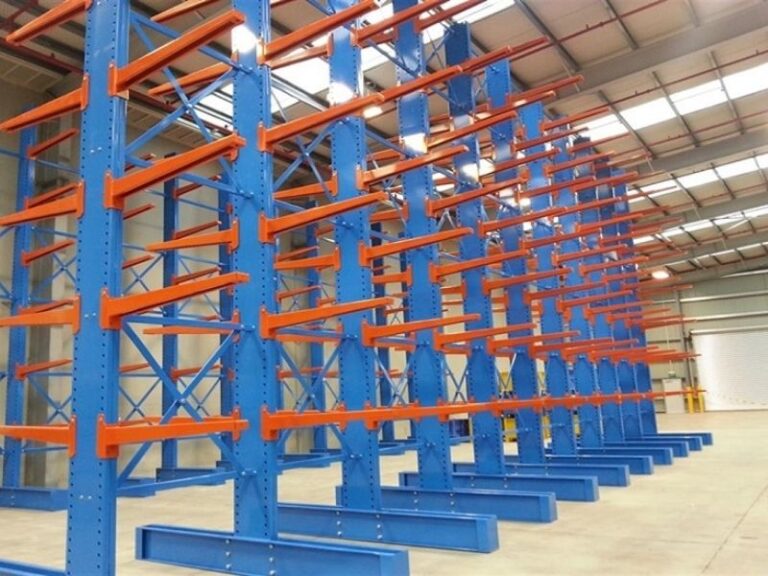Cantilever racking is a versatile and robust storage solution designed to accommodate long, bulky, and irregularly shaped items that traditional shelving systems can’t handle efficiently. Commonly used in industries dealing with lumber, pipes, steel, and other heavy materials, cantilever racking maximizes warehouse space and improves accessibility. This blog will delve into the benefits of cantilever racking, its different types, and how it can be tailored to meet specific storage needs.
Why Choose Cantilever Racking?
- Ideal for Long and Bulky Items: Cantilever racking is specifically designed for storing items that are too long, heavy, or awkwardly shaped for standard shelving. The absence of vertical obstructions allows for easy storage of lengthy materials such as timber, steel bars, pipes, and even furniture.
- Flexible Storage: Cantilever racks are highly adaptable and can be customized to fit a wide range of storage needs. The arms of the racking can be adjusted to different heights, allowing for various configurations depending on the size and weight of the materials being stored. This flexibility makes cantilever racking an excellent choice for warehouses with diverse inventory.
- Easy Access and Handling: One of the key advantages of cantilever racking is the ease with which items can be loaded and unloaded. The open design means that forklifts can easily access items from the front, which speeds up the handling process and reduces the risk of damage to the materials.
- Efficient Use of Space: Cantilever racking maximizes the use of vertical space in a warehouse. By stacking items vertically, you can store more within the same footprint, freeing up valuable floor space for other operations. This is particularly beneficial in warehouses with limited space or those looking to increase storage capacity without expanding their facility.
- Durability and Strength: Cantilever racks are built to withstand heavy loads and harsh industrial environments. Constructed from high-strength steel, they are capable of supporting significant weight, making them ideal for storing heavy-duty materials. The robust design ensures that your racking system will last for years, even with constant use.
Types of Cantilever Racking
- Single-Sided Cantilever Racking: This type of racking is installed against a wall, with arms extending from only one side. It’s ideal for warehouses with limited space, as it allows you to store items along the perimeter of the facility, freeing up central areas for other activities.
- Double-Sided Cantilever Racking: Double-sided racking has arms extending from both sides of the central column, allowing for storage on both sides. This type of racking is typically used in the middle of a warehouse, providing maximum storage capacity in a given area. It’s perfect for facilities with larger floor spaces.
- Light-Duty Cantilever Racking: Designed for lighter materials, this type of racking is suitable for storing items like pipes, plastic tubing, and light construction materials. It’s a cost-effective solution for businesses that need to store lighter items in an organized manner.
- Heavy-Duty Cantilever Racking: As the name suggests, heavy-duty cantilever racking is built to handle substantial weight loads. It’s ideal for storing heavy materials such as steel beams, large timbers, and heavy machinery parts. This racking is engineered to provide maximum strength and durability, ensuring the safety and stability of stored materials.
- Outdoor Cantilever Racking: This type of racking is designed to withstand the elements, making it suitable for outdoor storage. It is often used by industries that store materials like lumber and metal that can be stored outside. Outdoor cantilever racking is typically galvanized or coated to protect against rust and corrosion.
Key Considerations When Installing Cantilever Racking
- Load Capacity: Determine the weight and dimensions of the items you plan to store on the cantilever racks. This will help you choose a racking system that can safely support the load without compromising on safety or durability.
- Space Planning: Assess the layout of your warehouse to decide where the cantilever racking will be most effective. Consider the height of your facility’s ceilings, the width of aisles, and how much space is available for maneuvering forklifts and other equipment.
- Customizability: Choose a cantilever racking system that offers flexibility in terms of arm length, height adjustment, and spacing between arms. This will allow you to adapt the racking to your specific storage needs and accommodate different types of materials as your inventory changes.
- Safety Features: Ensure that the cantilever racking system you choose includes essential safety features, such as end stops, which prevent items from sliding off the ends of the arms, and base plates that stabilize the racking structure.
- Quality of Materials: Invest in high-quality materials and construction to ensure the longevity and reliability of your cantilever racking system. Steel racking is generally the best option for durability and strength, especially for heavy-duty applications.
Conclusion
Cantilever racking offers a practical and efficient solution for storing long, bulky, and irregularly shaped materials. Its versatility, ease of access, and ability to maximize space make it an ideal choice for warehouses and industrial facilities. By choosing the right type of cantilever racking and ensuring proper installation, you can enhance your warehouse’s storage capacity, improve operational efficiency, and create a safer working environment.
If you’re considering cantilever racking for your facility, Sama Racking can help you find the perfect solution. Our team of experts will work with you to design and install a cantilever racking system that meets your specific needs and ensures optimal performance. Contact us today to get started!


